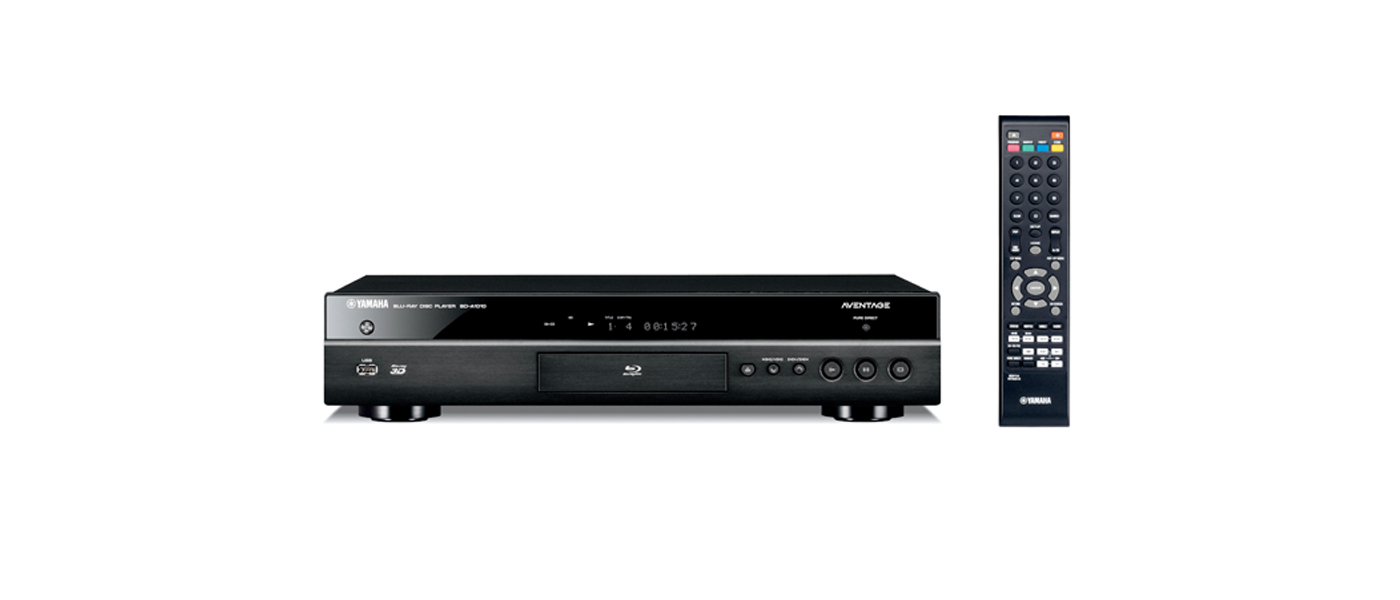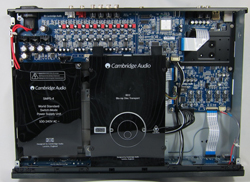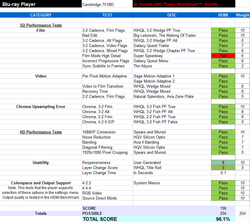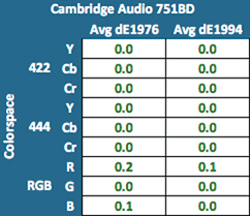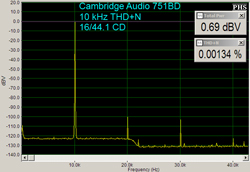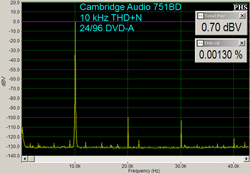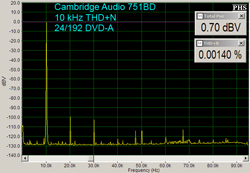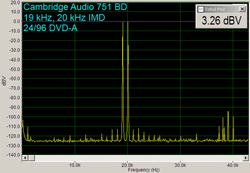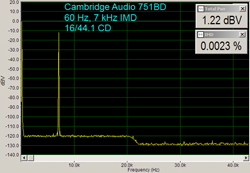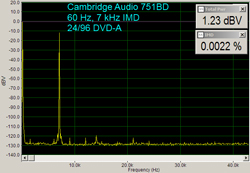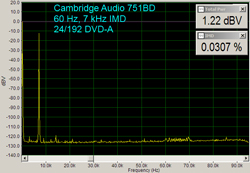Introduction to the Cambridge 751BD Universal Blu-ray Player
In a bit of a surprise, the Universal Blu-ray player market has gone through a big upswing recently. While DVD-Audio and SACD might be considered dead audio formats to the mainstream media, more and more players for home are including support for them now. One fairly recent addition to the group is the Cambridge Audio 751BD Audiophile Blu-ray player. It also supports 3D Blu-ray, and I was quite excited to have the chance to try out this unit myself.
SPECIFICATIONS FOR THE CAMBRIDGE AUDIO 751BD UNIVERSAL BLU-RAY PLAYER
- Design: Universal Player, Including 3D Support
- Codecs: All, Including Dolby TrueHD and DTS-HD Master Audio
- Streaming Support: YouTube, Picasa, Local Network
- Connections: Two HDMI 1.4a, Composite Video, Component Video, Optical and Coaxial Audio, LR RCA Audio, 7.1 Multichannel Audio, sSATA, USB, Ethernet, RS-232, IR
- Dimensions: 3.3″ H x 16.9″ W x 12.3” D
- Weight: 11 Pounds
- MSRP: $1,149 USD
- Cambridge Audio
- SECRETS Tags: Blu-Ray, Universal Players, 3D
Design and Setup of the Cambridge 751BD Universal Blu-ray Player
A quick glance at the 751BD and you can quickly see some of its roots. The Cambridge player uses the same form factor and core video chipset as the Oppo BDP-93 and BDP-95 players, which is a good choice as it is still the best performer we have seen in our testing. While many other universal players would stop there, Cambridge has an audio section with their own design that utilizes five Wolfson WM8740 DACs in the design, the same DACs used in their DacMagic and 740C CD player. It also has a custom designed, switch mode power supply, and the drive mechanism and chassis are both acoustically dampened.
Added on to the front panel is a selection for different digital filters: linear phase, minimum phase, and steep. When designing almost any component you need to make a trade-off somewhere, and in using a DAC this is no different. Cambridge has let you decide which trade-off sounds best to you, or works best with your equipment and sources. The manual goes into more depth on these filter modes, and later I run some of the bench tests in all of them so we can see what differences we find.
Cambridge was also nice enough to include the Wi-Fi adapter with the 751BD so you don’t need to add one on if you need it, as the case construction prevents the use of an internal antenna. The included remote from Cambridge is build very solidly, and had a very nice feel in the hand. I do wish it were backlit, as using it in a completely dark room while watching a movie required me to use an additional light to find the correct button. They could also make the Play/Pause button and other common buttons larger to make it easier to use just by feel in the dark.
Setup was very straight forward, as I have Oppo players for my standard unit. I connected the HDMI output to my Marantz AV7005, and the analog outputs to the multichannel input on the Marantz. Video was set to 1080p with support for 24p and the 4:4:4 colorspace most of the time, though I did use Source Direct with a Radiance Mini3D sometimes as well.
The Cambridge 751BD Universal Blu-ray Player In Use
The 751BD arrived right after I installed a 122” screen and projector in my new house, so needless to say there was a lot of movie watching going on. In all respects, the 751BD performed admirably here, as I expected with its video section design. Blu-ray load times were fast, and menus were responsive in use. Seek times after making a selection did seem slower than other players, as I couldn’t quickly hit the Next Track/Chapter button continually and have it keep up with me. The only other fault I had with Blu-ray playback was the previously mentioned lack of a backlit remote, or an iOS app, for controlling in the dark.
With 3D Blu-ray content I didn’t have any issues in playback either. Watching Tron Legacy, The Lion King, and Toy Story 2 all looked fantastic, even if I am not a big 3D guy. I’ve had previous players experience hiccups on some 3D content and I ran into none of those on the 751BD. Now that Netflix has both Mad Men and Breaking Bad available for me to catch up on, I’ve been using their streaming far more. Because of this is really caught me off-guard when the 751BD only offers Picasa and YouTube for Internet streaming. With more and more content available online, and more people relying on it instead of cable TV or movie rental stores, the lack of any sort of movie or television streaming was a bit odd.
The 751BD was able to play back media that was found over my home network, despite the lack of Internet streaming. DVDs that I had converted to MKV (H.264 video and AC3 audio) played back fine, as did some other MPEG and AVI files that I tested. It also did well streaming audio from my network, which was important since it lets me take advantage of the Wolfson DACs (pictured below) as there is no DAC input. While my FLAC files did play back fine, navigating them was a bit of an ordeal since there was no search feature, and only a handful of artists or albums fit on the screen at once. If your DLNA server supports browsing by letter it will be easier, but with a large music library it can take forever to get to the album you want to hear.
The main reason you would likely buy the 751BD is for its audio playback, and for that I decided to compare it to the Oppo BDP-83SE. Both were hooked up to the Marantz AV7005 with identical RCA cables and with Pure Direct mode enabled on the processor to add as little to the signal as possible. Additionally inputs were level matched to make the comparison as accurate as possible. I began with REMs early 90’s album “Automatic for the People”, since I have two copies of it and I’ve listened to it at least a hundred times.
The two players were very close as I switched back and forth; with the main difference being the 751BD throws a bit more enveloping of a soundstage. Instruments came further out from the speakers, and the piano chords at the opening of Nightswimming seemed to surround me a bit more in the room instead of being more towards the speakers themselves. Michael Stipes vocals also reached out a bit more from the speakers, and a bit more clarity to his voice.
Listening to the recent SACD release of Pet Sounds from The Beach Boys, the Cambridge 751BD sounded spectacular. Together the remastering by Mobile Fidelity and the Cambridge were able to show off the age and quality of the original master, but still bring the music to life. The wonderful melodies on God Only Knows came to life through the speakers, with clear separation between instruments and a very good soundstage once again. The 751BD proved to be an excellent player and should merit considering for anyone just looking at a CD player in this price range as the Blu-ray playback can be considered a bonus.
The Cambridge 751BD Universal Blu-ray Player On the Bench
Given the components of the Cambridge 751BD, I had high hopes for how it was going to perform on our bench tests, and in no way was I let down. It came very, very close to pulling down a perfect score on the Blu-ray Bench Test, with it occasionally losing the lock on the Super Speedway test clip, and the fact that other players are just slightly more responsive. The responsiveness issue is likely due to the quiet, dampened drive mechanism that takes a bit longer to find a track, but once it does it was dead silent in use. I’ll take the trade-off of a slightly slower seek time for better in-use performance myself.
The one thing I did not is that some wedge patterns showed a little bit of edge enhancement that I was able to eliminate by setting the sharpness control to -16. This didn’t seem to make lines fuzzy or scenes less detailed, but instead took away a slight bit of edge enhancement that the Cambridge was applying. I’d recommend doing the same on the unit if you use one.
On the HDMI Bench Test, the Cambridge also flew through, with practically perfect results. The YCbCr results were 100% perfect at both 422 and 444, and the dE values for the RGB data was under 0.1, which is so insignificant as to not even merit consideration as a detriment. We have recently improved the processing of the HDMI Bench Test so that we can now fully analyze all the results, and not just a subset of them, so the data presented is even more accurate than before.
We also have a new way to present the Blu-ray HDMI Benchmark Data, with images showing the reference data at the top, and the player data at the bottom. As you can see here, the top and bottom are identical, so the images are really quite boring to look at.
The Cambridge was also very fast at loading titles. The only result that wasn’t elite was Toy Story 3, which has the most disc seeks of any of the tests. Other than slightly slower track seek times, the Cambridge can hang with anyone in speed tests.
Of course people are buying the Cambridge 751BD for its audio performance as well, and on the bench it really did not disappoint. Results were fantastic all around, with a low, flat noise floor all the way out and numbers there were good at all sample rates. I ran some initial tests with all the various filters and the results were very, very similar on the bench, so I ran the rest of them on the Linear filter. I would suggest that anyone that buys the player listen to all the modes on their own and see which they prefer. The bench tests indicate that all will offer excellent performance.
Regardless of sample rate, these all measured right around 0.0008% THD+N with over 100 dB of headroom, which is an excellent result for any CD player, and especially for a Blu-ray player.
Here we measured in the 0.0013-0.0014% range with 100 dB of headroom again, which was still excellent for the 10 kHz THD+N result. You can see the noise floor is flat all the way out, without a slow rise up or other artifacts that some players can have.
IMD performance with 19 kHz and 20 kHz test tones was also fantastic, with very small side peaks, and 90-100 dB of dynamic range again.
IMD performance with the 60 Hz and 7 kHz test tones was also fantastic. The levels were higher with the 24-192 tones, but still very, very good overall. The noise floor was low and the dynamic range was very high. In the end, the Cambridge 751BD was a stand out performer on the bench tests.
Conclusions About the Cambridge 751BD Universal Blu-ray Player
Oppo and their implementation of the Mediatek chipset have set the bar for Blu-ray players very high. Other players might have the same chipset, but don’t offer close to the same performance. With our HDMI Benchmark I am often so surprised to see any player score decent on it that just being accurate in decoding, much less having good processing, seems to merit an award now. Thankfully there are other vendors out there that want to make a universal player that we can hold up for acclaim.
The Cambridge 751BD was a spectacular Blu-ray player on our benchmark tests, wonderful on the audio bench tests, and is incredibly well built. It is a quality product that has impeccable fit and finish and an audio section that will please the most demanding audiophile. The only complaint I can muster after a few weeks with the 751BD is that the remote isn’t backlit, which I hope they can remedy in the future. Beyond that small nit-pick, anyone that wants to own one of the best Blu-ray players on the market needs to demo the Cambridge 751BD, as it really is a fantastic unit. It’s only mid-January when I write this, but I doubt I’ll see a better player this year.


